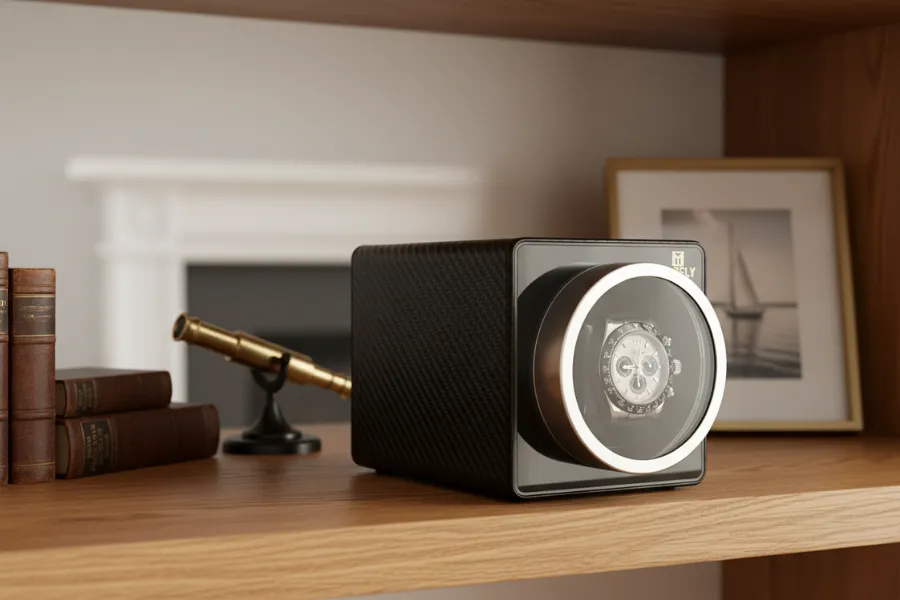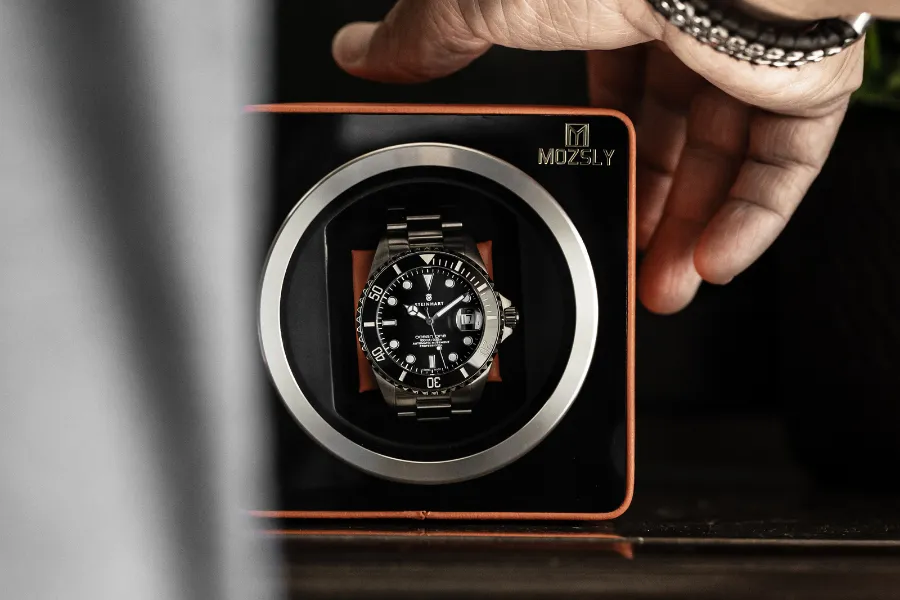Share This Post
Introduction
My friend got his first Seiko automatic wrist watch last year. He’s not a massive fan of winding his watch manually, so he purchased an automatic watch winder for convenience.
One day, he asked me about how long it takes to start a watch winder. He waited two to three minutes for his watch winder to start and wondered if this was a normal delay.
His message reminded me of powering on my first watch winder and feeling the same way.
People expect devices to start quickly. They often get anxious, fearing that their devices are doomed when they start slowly.
Now don’t worry. I’m here to help.
In this guide, I’ll give clear timeframes so you know what to expect when you turn on a watch winder. I’ll also show when to worry and how to fix common problems.
I’ve helped my friend in the same way, so I hope I can be of service to you as well.
Without further ado, let’s dig deeper together.
Watch Winder Timing: Normal vs. Abnormal
Waiting for something to initialize is like playing with a jack-in-the-box.
You don’t know what you’ll get – nothing happens, or a sudden scare. So you get nervous and worried.
As the saying goes, fear comes from ignorance. Knowing what should happen and when reduces anxiety.
I’ll break down this process with a timeline, so you can have a clearer view of what to expect.
Initialization Stage: Instant Power-On
When you plug your watch winder in and switch it on, immediate signs should appear in 0–5 seconds.
You should notice that the LED lights in the watch winder turn on (if there are any). The display or menu backlight should activate. A tiny beep or display message may also appear.
If these signs appear within seconds, the unit is powered on. Wait for it to initialize before proceeding.
Operational Readiness
After the lights come on, the winder usually starts rotating or begins its programming routine within 5–30 seconds.
Many models take about 10 seconds to set preferences before starting automatic operation.
Do not panic if the motor does not spin immediately. A brief pause is normal during boot-up and settings check.
You can think of this process as starting a computer or a laptop. There’s always a short gap between initialization and full boot.
Red Flags: Abnormal Scenarios
After discussing everyday situations, we need to examine the abnormal ones.
We still think of it as the computer. When your computer takes a long time to start up, it usually means that something has gone wrong.
It could be due to a computer virus or excessive junk files consuming memory.
Similarly, watch winders that take too long to start are usually a bad sign. But what exactly counts as an abnormal sign during startup?
If you notice any of these specific indicators, you need to pay more attention:
- No LEDs or display after 10 seconds.
- No sound or activity after 30 seconds.
- Odd grinding sounds or stuttering when the motor starts.
- The unit only responds when shaken or tapped.
These signs point to setup issues. You may have a faulty adapter or a defective unit.
Either way, you should unplug the watch winder for a thorough check when you find any of these.
Complete Breakdown: From Setup to Fully Wound Watch
Imagine you just got your first watch winder. You unbox it, plug it in, turn it on, and put your watch inside. How long should this whole process take?
Well, there’s no exact answer. The time varies by the brand and model of the watch winder.
Still, you can take my timing from setting up my first watch winder as a reference.
Initial Setup Phase
After unboxing and checking the contents, I plugged in the AC adapter (or inserted batteries if supported) into the watch winder.
Then I flipped the master power switch to the ON position and programmed the winder using the controls.
This process should take about 2–5 minutes.
Before putting your watch in or removing it, remember to turn the power OFF.
I learned this the hard way. I once tried to put my watch inside the watch winder just because of curiosity, and I almost damaged the crystal of my watch.
Take my lesson and don’t try that, seriously.
First Operation Cycle
After placing your automatic wrist watch in and turning it on, the watch winder will begin to spin and wind your watch.
Most automatic watch winders will rotate for 30 seconds to 1 minute, then stop.
Don’t worry, this pause is normal. It’s part of the TPD-controlled run/rest cycle.
“What’s TPD?” You may ask. TPD is the abbreviation for Turns Per Day. It determines how many rotations a watch gets in a 24‑hour period.
Different watch winder has different TPD presets for various watches. I’ll talk about this more specifically later.
Complete Watch Winding Duration (8–24 hours)
How long will it take for your watch to be fully wound? That depends.
Most automatic watches have a power reserve of around 40–60 hours. If your watch has run out of power, a watch winder can take many hours to reach a full charge because it only simulates how you wear it.
You can refer to the user guide or manual published by the watchmaker to determine the time it takes to fully wind your watch.
Some owners prefer to manually wind the crown of their watches about 20–30 turns before placing them in the watch winders. They do this to speed up the winding process.
So expect anywhere from 8 to 24 hours of watch winder use to bring an empty automatic watch up to a useful reserve.
If you want your watch to be ready quickly, you can give it a few manual winds before using the watch winder.
Troubleshooting Startup Delays
If your watch winder is slow to start or not starting at all, check these common causes.
Power Connection Issues
If your watch winder is completely shut down or takes a long time to start, ensure the AC adapter matches the unit.
Also, pay more attention to plugs. Make sure they are tight enough. Loose plugs are very likely to be missed when troubleshooting.
Many watch winders have both AC and battery power systems, but they cannot be used simultaneously. You can’t have your cake and eat it too.
I suggest selecting one option based on your situation for optimal use.
Some models offer USB power. It’s handy for tucking a watch winder into a shelf out of the way of outlets.
Programming Mistakes That Cause Delays
When using the watch winder, selecting the incorrect TPD or rotation direction can cause it to behave erratically and have delays when starting.
To avoid these issues, I suggest that you always check the watchmaker’s recommended TPD and follow the directions as mentioned in the user manual or guide.
For initial testing, especially with a new watch, you should start with a gentle setting (e.g., 650 TPD). I always do this to protect my watch winder and the watch it holds.
This setting is not too fast to damage the motor of the watch winder and your watch. It’s also not too slow to wind your automatic watch inefficiently.
Watch Placement Problems
If you find that your watch winder is starting slowly, there may be issues with the watch placement.
The watch should fit snugly on the cushion. Loose mounting often appears to be a startup problem. If that happens, you need to adjust your watch winder.
It might also be caused by you — you probably place your automatic watch into the watch winder the wrong way. Check again and take action right away if you actually did.
Always remember to turn the power off while swapping watches. You’ll avoid pinching straps and motor strain in this way.
Specific Timing Examples
You might notice that different watch winder brands often use different timing cycles. One winder might run for 8 minutes and rest for 4 hours, while another runs for 30 minutes and rests for 3 hours.
It seems confusing, but don’t worry. The most important thing to know is that, regardless of the exact schedule, the underlying goal remains the same.
Every quality watch winder aims for the same result: to gently give your watch the right number of TPD — no more, no less. They all want to keep your watch running optimally without overwinding it.
I will use the Mozsly watch winder, for example, since I’m more familiar with it. But you can always apply this general idea to any brand you are considering.
Understanding the TPD Cycles
For any watch winder, understanding the exact winding mode is crucial for optimal use and maintenance.
Understanding these specifications can be very useful for planning and comparing the settings.
You can also try different settings to find the most optimal routine for you and your watch.
As for the Mozsly watch winder, it comes with 4 different presets, each with a unique run/rest cycle.
They’re suitable for any weight of the watch, so no need to worry about something like “Oh no, my watch is too heavy for it.”
Specifically, these 4 presets are:
- I: 650TPD, running time 3 minutes 28 seconds, rest time 56 minutes 32 seconds, continue to cycle
- II: 850TPD, running time 4 minutes 28 seconds, rest time 55 minutes and 32 seconds, continue to cycle
- III: 1050TPD, running time 5 minutes and 28 seconds, rest time 54 minutes 32 seconds, continue to cycle
- IV: 1250TPD, running time 6 minutes and 28 seconds, rest time 53 minutes and 32 seconds, continue to cycle
I like starting with Mode I to see how my watches respond, and adjust the settings based on my personal situation. You can apply this idea to any watch winder you’re thinking of.
Power Source Impact on Timing
The Mozsly watch winder comes with two different ways to power it. Choose based on your situation.
The AC power (100–240V) delivers steady performance and is ideal for long-term use.
You can also utilize the modular features of Mozsly to build a storage system by using a cable to connect them together.
On the other hand, the 2 AA battery operation is slower to start in some models.
However, it’s great for concealing your watch winder inside furniture or on shelves where power outlets aren’t readily available.
If you want to put your watch winder into a drawer, two batteries are what you need.
Quick-Start Tips for Daily Use
Here are some personal tips I summarized from my experience with the Mozsly watch winder. I also suggest them to other friends with watch winders.
One of them was quite doubtful about whether these tips were universal, so he took my advice on his watch winder, which was a different brand.
As for the outcome, he was completely convinced after seeing his watch winder start up faster. I hope these tips will be of benefit to you as well.
When using your watch winder, start with low-TPD mode (such as Mode I in Mozsly) for one week and observe how each watch keeps time.
If the watch loses time, bump up the TPD slowly.
If you use multiple watch winders, utilize the modular designs if available. You can chain your watch winders together, simplifying cabling and saving more energy.
Speed Optimization Tips You Can Use Today
Want to save time and manage more watches? You can try these practical hacks.
Time-Saving Daily Routine
Don’t treat every watch in your collection the same way. Optimizing the way you treat your watch can yield twice the result with half the effort.
To do so, you can keep frequently worn watches on a simple cycle, and less-used watches on longer rest intervals.
You can also utilize daisy-chain capability (if available) to power multiple watch winders simultaneously with a single adapter.
Avoid placing your watch winder in areas with high humidity or dust. Dust and water can bring serious damage to the watch winder, causing it to start slowly or malfunction.
When to Use Quick vs. Custom Settings
Preset modes are fast for daily use. If you are too busy or lazy to set up your own, just use the preset. Nothing to be ashamed of.
On the contrary, custom programming helps if your watch has an unusual movement or specific needs. Refer to the manual or consult the manufacturer for further details.
Generally speaking, many automatic wrist watch winders work bi-directionally. Many movements need only 650–900 TPD to wind. So, presets are enough for most cases.
Battery vs AC Power for Convenience
Use batteries when you need a clean display or a cordless look, and use AC for continuous, worry-free running and modular storage system building.
Let’s say you want to take one or two watch winders for travelling.
If you want a fast-start watch winder, but don’t want to take or can’t fit the power adaptor in your suitcase, batteries become handy now.
Either way, always make the optimal choice based on your cases.
Conclusion
Now you know what should happen when starting a watch winder, and how long it should take. Let’s recap everything again.
- Power-on: 0–5 seconds for lights/display.
- Programming: about 10 seconds to set choices.
- First spin: 30 seconds–1 minute for the initial run.
- Full winding: typically 8–24 hours (or manual wind first to speed it up).
If your watch winder has delays when you turn it on, quickly go through this checklist:
- Is the adapter plugged in and correct?
- Are LEDs or displays active?
- Is the TPD and direction set reasonably (start with 650 TPD)?
- Is the watch seated properly and powered off when swapping?
- Is there any solution for this situation in the watch winder’s user guide or manual?
- Is there any dust or moisture getting into the watch winder?
If any of these above didn’t happen, just wait. A little patience at first saves headaches later.
Once you have your automatic watch winder set up — whether it’s a Mozsly watch winder or another high-quality watch winder — it’ll quietly keep your watches ready to wear.
I hope this helps you feel more confident about turning on your watch winder. If you find this useful and helpful, share it with your friends who have the same concern!
Related Post's
Featured Video
Provide an email subscription feature for users to sign up for updates.
Follow the world of watches and cigars for exclusive content!
By subscribing to our newsletter, you will be the first to receive notifications of our latest articles, popular posts and special events.








